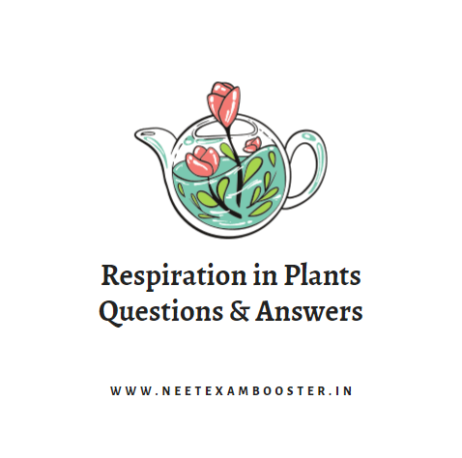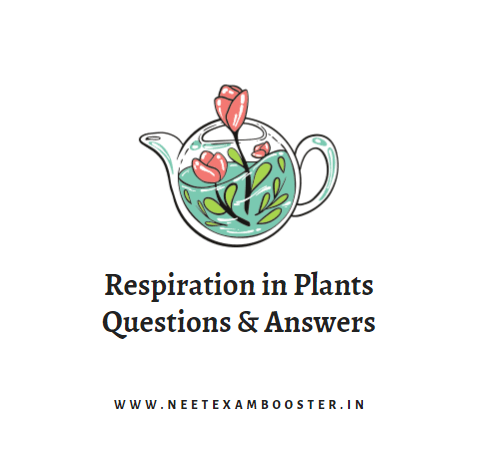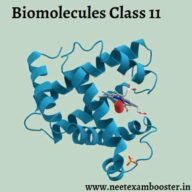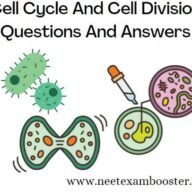Respiration in Plants Class 11:- Living beings need energy to perform every function,like transportation, breathing, reproduction, movement, absorption etc.
Respiration in Plants Class 11 – Introduction
This energy can be gained by oxidising some of the macromolecules which is known to be food. Green plants and the cyanobacteria can only make their own food ,hence they are called autotrophs .They trap light energy and convert that into chemical energy to make their food by the process of photosynthesis. Meanwhile organisms like animals obtain their food from the plants,hence they are known to be e heterotrophs.
This chapter basically deals with the process of cellular respiration i.e. the breaking of food materials and release of energy as a result in the form of ATP molecules.

Let us study this in more detailed form .
Respiration in Plants Class 11 – Very Short Answer Type Questions
Q.1. How energy is released and stored during the oxidation of compounds in the process of respiration?
A.1. Energy released is directly stored in ATP in form of chemical bonds. ADP + IP + energy → ATP. This bond is broken and utilized whenever required, ATP → ADP + IP + energy.
Q.2. What do u mean by ‘Energy Currency’. The substance that acts as an energy currency in animals and plants is?
A.2. Energy is required by every cell to perform any function. Energy currency releases and stores energy as and when required in the cell at any time. In both plants and animals, ATP is called the energy currency of the cell.
Q.3. Anaerobic respiration in man and yeast takes place in ?
A.3. In man, anaerobic respiration occurs when there is a lack of oxygen during the cellular respiration, hence here pyruvic acid is reduced to lactic acid by the enzyme lactate dehydrogenase. In yeasts, also it occurs in absence of oxygen.
Q.4. On oxidation, which of these produces greater energy? Organize them in an ascending order.
a) 1gm of fat.
b) 1gm of protein.
c) 1gm of glucose.
d) 0.5gm of protein + 0.5gm of glucose.
A.4. 1gm of fat releases greatest energy. Following is the ascending order of energy-
1gm of glucose < 0.5 gm of protein + 0.5gm of glucose < 1gm of protein < 1gm of fat.
Q.5. Fo-F1 particles which are also called oxysomes are involved in the production of?
A.5. They both are present in inner mitochondrial membrane and are involved in synthesis of ATP which is called the energy currency of the cell.
Q.6. Write the formed product of the following?
a) Aerobic glycolysis in the skeletal muscles.
b) Anaerobic fermentation in the yeast.
A.6.
a) The product is Pyruvic acid.
b) The product is C2H5OH + CO2.
Q.7. Where is the electron transport system ETS happens in the mitochondria of a cell?
A.7. Inter membrane space of mitochondria of the cell is the site of oxidative phosphorylation, where ETS occurs.
Respiration in Plants Class 11 – Short Answer Type Questions
Q.1. Why a person is fed with glucose or a fruit juice instead of a cheese sandwich that might give more energy, when a person is feeling dizzy or weak?
A.1. Glucose gives instant energy as it is absorbed and reaches the blood. Cheese sandwich, however, requires more time to digest and to get absorbed. As sick people need an immediate energy supply, they are fed with glucose or given fruit juice to avoid weakness.
Q.2. “Aerobic respiration is more efficient”. Explain the following.
A.2. In aerobic process, a single molecule of glucose can yield up to 36 molecules of ATP molecules. In anaerobic respiration or in the process of fermentation, there are only the production of two molecules of ATP from every molecule of glucose, which in comparison is lesser than aerobic respiration.
Hence aerobic respiration is more efficient in comparison to anaerobic respiration.
Q.3. Final product of glycolysis is pyruvic acid. Write the three metabolic fates of pyruvic acid in anaerobic and in aerobic conditions as seen in the diagram below.
A.3. Lactic acid is formed by the oxidation of pyruvic acid in the skeletal muscles under anaerobic conditions.
Ethanol is formed by oxidation of pyruvic acid under anaerobic condition in the yeasts Acetyl Co-A is formmed by the oxidation of the pyruvic-acid occurring under the mitochondria under the aerobic conditions.
Respiration in Plants Class 11 Quiz
Q.4. Anaerobic respiration is observed in living organisms such as the human beings and angiosperms in aerobic conditions. Why is this so?
A.4. In normal conditions , aerobic respiration takes place in the human beings. In intense/extreme conditions such as heavy exercises, muscles requires lot of energy in the form of ATP hence consumes a lot of more energy to be able to produce that energy which results in lack of oxygen thereby causing muscles to produce lactic acid through the process of anaerobic respiration to meet the emergency energy requirements. Under deficient conditions of oxygen, the yeast cells carry out anaerobic respiration to form the ethyl alcohol and carbon dioxide.
Q.5. The Respiratory pathway is considered as amphibolic pathway. Comment.
A.5. Fatty acids and the proteins are degraded to acetyl CoA to enter respiratory pathway. Substances are withdrawn from the respiratory pathway during the synthesis of the fats and the proteins and are used in anabolism.
Formation of the substances is called anabolism and breakdown of the substances is known as catabolism. Since, the respiratory pathway is responsible for both the process of catabolism and anabolism, it is called as the amphibolic pathway.
Q.6. Mitochondria is called the powerhouse of the cell? Comment.
A.6.Mitochondria is the powerhouse of the cell because they play a vital role in releasing energy from food molecules through a series of enzymatic reactions following different pathways.
Q.7. The process of Oxidative phosphorylation results in?
A.7.Oxidative phosphorylation results in the production of ATP – Adenosine triphosphate and water molecules.
Q.8.Explain the term “Energy Currency” of the cell?
A.8. ATP is known as the “Energy Currency” of the cell.
ATP – Adenosine triphosphate is organic compound i.e. composed of the phosphate groups, adenine, and the ribose sugar. These molecules provide energy for the various biochemical processes in our body. Hence , known as “Energy Currency of the Cell”.
Respiration in Plants Class 11 – Long Answer Type Questions
Q.1. Give significance of oxygen molecule in case of aerobic respiration in the context of ETS ,the electron transport chain.
A.1. Aerobic process of respiration occurs in existence of the oxygen molecule and the function of oxygen is limited to final phase of the process. Presence of the oxygen molecule is important as it drives the process by eliminating the hydrogen molecules from system. Oxygen molecule serves as the last Hydrogen acceptor.
In the process of respiration, the energy of oxidation-reduction is used as opposed to process of photophosphorylation where the light energy is used for the production of proton gradient that is required for the phosphorylation. Hence it is known as oxidative phosphorylation. Without the oxygen molecule, the electrons cannot pass through the co-enzymes and in turns the proton pump will not take place. Hence the ATP molecules will not be generated.
Respiration in Plants Class 11 toppers notes
Q.2. Which are the assumptions we make in respiratory balance sheet? Are these valid enough to apply for the living systems? Write the difference between the aerobic respiration and the fermentation process corresponding to respiration.
The following are some of the assumptions:
- The sequential pathway that follows the TCA cycle, glycolysis, and ETS in cytoplasm, mitochondrial matrix, and the inner mitochondrial membrane respectively.
- NADH, that is synthesized in the process of glycolysis enters into the electron transport chain , ETC for phosphorylation.
- In this pathway, not only one intermediate is utilized for synthesis of compounds.
- Glucose produces the respiratory substrate.
These assumptions cannot be appllied to the living system as:
- This pathways occur simultaneously and not one after the other.
- Atp is utilised only when it is required.
- Enzymatic action rates are regulated by several means.
Listed below is the comparison between fermentation and aerobic respiration
| Fermentation | Aerobic respiration |
| 1.Here the inncomplete disintegration of glucose molecules takes place. | 1.A complete breakdown of the glucose molecule takes place. |
| 2.Oxidation of NADH to NAD+ is a slow process. | 2.Aerobic respiration, is a vigorous reaction. |
| 3.Two molecules of ATP are generated. | 3. 38 molecules of ATP are generated. |
Q.3. Define Glycolysis. What is the end product of it and where does it occurs? Determine the fate of the products in aerobic and anaerobic respiration.
A.3. Glycolysis takes place in cytoplasm of a cell and is seen in all living beings. In glycolysis,glucose goes through partial oxidation for formation of pyruvic acid(2 molecules). It is obtained from sucrose in the plants which is the resulting product of the photosynthesis. The enzyme Invertase converts sucrose into fructose and glucose which enter into the glycolytic pathway. These are phosphorylated to produce glucose-6-phosphate which isomerizes to generate fructose-6-phosphate. A sequence of ten reactions regulated by the different enzymes occurs in the process of glycolysis to yield the pyruvate from glucose.
The chief product of glycolysis is the pyruvic acid. Cellular needs of the cell decides pyruvate’s metabolic fate. The three modes in which various cells manage pyruvic acid produced by glycolysis are –
1.Lactic acid fermentation
2.Aerobic respiration
3.Alcoholic fermentation
Under anaerobic conditions, in unicellular eukaryotes and prokaryotes, fermentation takes place. Kreb’s cycle or the aerobic respiration is observed in living organisms for complete oxidation of the glucose into carbon dioxide and water which requires supply of oxygen molecules.
Click here to join our telegram channel for more study materials like Respiration in Plants Class 11 Questions and Answers.



















